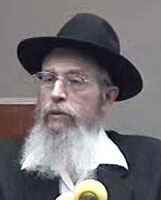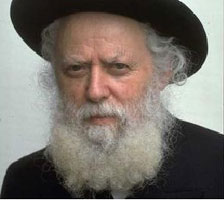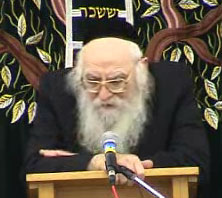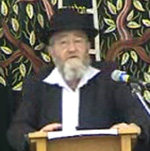Beit Midrash
- Torah Portion and Tanach
- Vayikra
- Emor
One of the many mitzvos in this week’s parsha is the prohibition against slaughtering an animal along with its offspring on the same day. In earlier generations, when Jews lived in a more rural setting, this mitzvah was more common. Nowadays however, it is very rare, for anyone – even a shochet – when this mitzvah is relevant, as we will soon see. Nevertheless, this mitzvah is part of our Torah and it is important to understand as much Torah as we can.
The Mitzvah
The pasuk in this week’s parsha states: "An ox or a lamb, you may not slaughter it and its offspring on the same day" (Vayikra 22:28). This prohibition is listed among the 613 commandments (Rambam, Sefer Hamitzvos, Lo Sa’aseh #101; Semag, Lavin #149; Chinuch #294).
Even though this part of the Torah deals with mitzvos related to korbanos, this particular mitzvah is a general one and applies even when there is no Beis Hamikdash (Chullin 138b). Furthermore, as this mitzvah is classified as a "chovas haguf" – a personal obligation, one must fulfill it both in Eretz Yisrael and in Chutz La’aretz (ibid. 78a; Rashi and Tosafos ad loc.). If one transgressed this prohibition when beis din had the authority, he was liable to receive malkos – lashes (Chullin 78a; Rambam, Hilchos Shechitah 12:1).
Kosher Cattle Only
The prohibition against slaughtering oso ve’es beno applies only to kosher cattle, i.e., cows, goats and sheep. This is derived from the fact that the Torah makes two specifications when outlining this mitzvah – "an ox or a lamb." (It should be noted that the Hebrew word for lamb, seh, refers to both sheep and goats.) The Gemara uses the specification of "ox" to exclude non-domesticated animals, e.g., deer, while the use of the word "lamb" excludes all fowl. It is therefore permissible to slaughter a doe and its fawn or a hen and its chick on the same day (Toras Kohanim; Rambam, Hilchos Shechitah 12:8; Shulchan Aruch, Yoreh Dei’ah 16:7).
Please note that when we give examples in this article of cow and its calf with regards to this mitzvah, we are not excluding the other species of kosher livestock, as the mitzvah applies equally to all of them. We merely chose one species for simplicity’s sake.
The Animal’s Gender
There is a three-way disagreement in the Gemara concerning which parent animal is included in the prohibition against slaughtering oso ve’es beno:
1) According to the Rabbanan, the mitzvah applies only to the mother animal. This view maintains it is only forbidden to slaughter the cow and one of her calves on the same day, but it is permitted to slaughter a bull and his calves on the same day. The Gemara (Chullin 78b) makes several points to prove this:
a) Referring to the parent, the Torah uses the word, "oso" – "it," as opposed to "osom" – "them." This indicates that only one of the two parents is included in the prohibition.
b) Furthermore, concerning the mitzvah of shilu’ach hakein – sending away the mother bird prior to taking the eggs or the chicks, the Torah specifies the mother bird. Therefore, the Rabbanan derive that just as shilu’ach hakein applies only to the mother bird, similarly oso ve’es beno applies to the mother animal.
c) Additionally, when outlining the mitzvah, the Torah refers to the offspring as "beno" – "its offspring." The Rabbanan understand from this that the mitzvah can apply only to the cow, as the calf has a natural affinity to its mother and follows her. This creates a situation where it is easily recognizable that this calf is the offspring of that particular cow. This phenomenon does not occur with the bull.
A difficulty with this approach, that "oso" refers to the cow, is that the word "oso" is masculine and would seem to indicate the bull. The Ramban (Vayikra 22:28) explains that in the previous pasuk the Torah mentions several animals in regards to korbanos. When the Torah then outlines the mitzvah of oso ve’es beno, the word oso is referring to the animals of the previous pasuk as well, which says that when an animal is born, it should be seven days with its mother before it may be offered as a korban. Therefore, oso refers to the parent mentioned in the previous pasuk.
Rashi, Targum Onkelos and Targum Yonasan all explain the pasuk according to the opinion of the Rabbanan. Ramban notes that we see that they paskined like the Rabbanan.
The Father Too
2) According to Chananyah, the mitzvah of oso ve’es beno applies to both the bull and the cow. Therefore, it is forbidden to slaughter either the bull or the cow with one of its calves on the same day. He derives this from the fact that the word "oso" is masculine, thereby referring to the bull, while "beno" indicates that the cow is also included, as the young animal cleaves to its mother.
Taking the Father into Account
Another element of this disagreement between the Rabbanan and Chananyah is the Talmudic concept of "chosheshin lezera ha’av." This refers to whether we are legally "concerned for the father’s seed." Although the young animal is a product of the male and female that produced it, the question here is whether, from there is any halachic status to the father of an animal. According to the Rabbanan, the calf is halachically only the offspring of its mother. Therefore, it can be slaughtered on the same day as its father. According to Chananyah, the calf is legally the offspring of both biological parents. Therefore, in his view, the mitzvah of oso ve’es beno applies to both the bull and the cow.
There is a third view among the Tanna’im, that of Rebbi Yehudah. He maintains that it is a safeik – a halachic doubt whether we are concerned about the father’s seed (Kesubos 111b). The Rambam and the Shulchan Aruch rule according to this opinion. Therefore, in a situation where we know for sure that a male animal sired the offspring, we are not allowed to slaughter both on the same day. However, according to Rebbi Yehudah, although one is liable for malkos when slaughtering the mother and its offspring, someone who slaughtered the bull and its offspring on the same day is exempt from malkos. This is because Rebbi Yehudah considers it a safek whether the prohibition of oso ve’es beno applies to the father (Rambam, Hilchos Shechitah 12:11; Shulchan Aruch, Yoreh Dei’ah 16:2).
Defining "On the Same Day"
The prohibition against slaughtering oso ve’es beno is that the two animals cannot be shechted on the same day. How do we define "the same day?" The Mishnah (Chullin 83a) states that we determine this based on the Torah’s definition of a day in relation to the six days of Creation. The pasuk (Bereishis 1:5) states, "And it was evening, and it was morning; the first day." Just as we find at Creation, the daytime follows the night, the same is true regarding the mitzvah of oso ve’es beno. In other words, if the shochet slaughters one animal on Tuesday night, he may not slaughter the second until Wednesday night. But if he slaughters the first on Wednesday afternoon, he may slaughter the second on Wednesday night. Once the night begins, it is considered a new day (Rambam, Hilchos Shechitah 12:17; Shulchan Aruch, Yoreh Dei’ah 16:4).
One or Two Transgressors
A person who slaughters the cow and its calf becomes liable upon performing the second shechitah. After all, there was no prohibition at all when he performed the first shechitah. If one person slaughters one animal, and another person slaughters the second, the latter shochet is liable for his act (Chullin 78a and 82b; Rambam, Hilchos Shechitah 12:1).
No Specific Order
In the next two sections, we will be discussing how this prohibition relates to multiple generations of animals. This is our cast: Cow A (grandmother) gave birth to Cow B (mother), and Cow B gave birth to Calf C (grandchild).
The wording of the pasuk is "you may not slaughter it and its offspring." Although this would seem to indicate that the prohibition applies to where one slaughters them in that specific order – first the mother and then the offspring, i.e., oso ve’es beno – the halacha is that the order is irrelevant (Shulchan Aruch, Yoreh Dei’ah 16:1). Even if the offspring is slaughtered first and its mother afterwards, which is referred to as "beno ve’oso," the shochet is liable. The Gemara then provides a scenario where the prohibition can apply to two shochtim. Shochet #1 shechts Cow B. Shochet #2 then slaughters Cow A. And finally, Shochet #3 shechts C. The last two shochtim have both transgressed this prohibition:
1) Shochet #1 shechted Cow B, and then Shochet #2 shechted Cow A. Shochet #1
transgresses "beno ve’oso."
2) Shochet #1 shechted Cow B, and then Shochet #2 shechted Cow C. Shochet #2 transgresses "oso ve’es beno."
The Number of Transgressions
In the previous section, we noted that the order in which the animals are slaughtered is irrelevant. There is a transgression of oso ve’es beno as well as beno ve’oso. In this section, we will again discuss multiple generations of cows but with only one shochet. This is in order to better understand the concept that with one act a person can transgress numerous prohibitions.
Let us begin with a very straightforward case. A shochet slaughters a cow along with two of its calves. With the slaughter of each calf, he transgresses the prohibition of oso ve’es beno. In the time of the Beis Hamikdash, he would be liable two sets of forty lashes.
If the order is reversed, i.e., he slaughters the two calves and then the mother cow, he is liable once for beno ve’oso. Since he can slaughter the mother only once, he is liable for only one prohibition.
Using our example above of Cows A, B, C, each representing a subsequent generation – if he were to slaughter the three cows in that order: A, B, C – he is liable twice for oso ve’es beno. This is because he slaughter two sets of mother/daughter and he is liable two sets of lashes.
If he slaughters the animals in the following order: A, C, B, we have a disagreement between the Tanna’im as to how many transgressions he has committed. According to the Tanna Kamma, he has transgressed only one prohibition. At first glance, this seems to be difficult. Let us explain why. He is not liable for slaughtering A and then C, as the prohibition does not cover "grandchildren." However, we have learned that the order of animals’ slaughter is irrelevant and one can transgress both oso ve’es beno as well as beno ve’oso. Therefore, the slaughtering of B should make him incur both oso ve’es beno (A and B) as well as beno ve’oso (C and B).
Rather, the reason why he is liable only one set of lashes is because, as Rashi explains, "it is one prohibition, one warning and one action." In other words, while it is true that beno ve’oso is forbidden as much as oso ve’es beno, they are still only one prohibition. Furthermore, in order to become liable for any prohibition, the potential transgressor must be forewarned by two witnesses that what he is about to do is forbidden. The witnesses must specify the prohibition and the penalty that will be incurred. In this case, when the shochet is about to slaughter Cow B, he would be told that he is going to transgress oso ve’es beno, as there is no unique prohibition called beno ve’oso, as it is included in the former. Furthermore, since he transgresses both with one act of shechitah, he can be liable for only one set of lashes (Mishnah, Chullin 82a; Rashi ad loc.).
Definite Knowledge and Assumptions
When slaughtering many animals, does a shochet have to be concerned that he might be slaughtering a mother and her calf? We will address this question in light of two sets of circumstances: 1) In earlier generations when it was common for Jews to raise cattle and 2) nowadays.
In earlier times, when people lived off the land, it was common for most people to own livestock. If a Jew bought an animal from a cattle dealer, he did not have to assume that the particular animal’s parent or offspring was slaughtered that day, and he was allowed to slaughter it immediately. However, if the seller slaughtered the parent or offspring of the sold animal that day, or had sold one of the two to a third party to be slaughtered on that day, the seller must inform the second buyer of this (Shulchan Aruch, Yoreh Dei’ah 16:6).
As we just said, someone who purchased an animal does not have to assume that the animal’s parent or offspring was slaughtered that day. However, the Mishnah (Chullin 83a) states that on four days of the year he may not make that assumption: Erev Pesach, Erev Shavuos, Erev Rosh Hashanah and Erev Shemini Atzeres (Hoshanah Rabbah). On those days, since the next day is a Yom Tov when we assume that people are preparing big meals, there is concern that the mother or offspring was also slaughtered on that day. There is an assumption that someone who purchased an animal on one of those four days will slaughter it that day so that he has enough fresh meat for Yom Tov. Therefore, if Reuvein purchased the cow on one of those four days, and then sells the calf to Shimon, Shimon will not be allowed to slaughter. This is different from the rest of the year, as we noted above, that Shimon is prohibited from slaughtering his animal only when Reuvein specified that he intended to slaughter the cow on the day of purchase (ibid., Shach, Yoreh Dei’ah 16: =ad loc.).
The Situation Nowadays
Nowadays, shochtim who come to slaughter large numbers of animals do not need to be concerned about oso ve’es beno. The assumption is that all the animals are permissible to be slaughtered. This is based on the premise of "rov" – the "majority" of animals are not limited by this prohibition. This is because, even after having slaughtered a certain animal, the majority of animals are neither the mother nor the offspring of the slaughtered animal.
If the shochet would happen to observe a cow and a calf and note that the calf consistently follows the cow, he must assume that the younger is the offspring of the older, and it is forbidden to slaughter them on the same day. Otherwise, the only other scenario when the shochet must refrain from slaughtering two animals on the same day is if he has definite knowledge that one is the mother and the other is the offspring (Shulchan Aruch, Yoreh Dei’ah 16:5).
I discussed this with rabbonim both in Eretz Yisrael and in the United States and was told that shochtim rely on this lechatchilah and are unconcerned about transgressing the prohibition of oso ve’es beno. Furthermore, it is highly unlikely that such an occurrence would ever take place, as animals are generally slaughtered for beef while they are still young. Once they calve, they are harvested only for use in delicatessen and sausage, because the older it gets the tougher is its meat, and the less tasty and valuable it is as beef. These meat packers are referred to in the industry as producing "bull beef." The chance that its offspring was shechted on the same day is (a) highly improbable and (b) humanly impossible to determine.kosher slaughter.
The Status of the Meat
If someone slaughters both the cow and its calf on the same day, thereby transgressing the prohibition against oso ve’es beno, is the meat prohibited?
When discussing the prohibition of oso ve’es beno, the Gemara (Chullin 115a) indicates that when this prohibition has been transgressed, it is only forbidden to use the second animal as a korban. However, it is permitted to eat the animal (Rambam, Hilchos Shechitah 12:1). However, some Rishonim maintain that the meat of the second animal should not be eaten on that day as a rabbinic penalty so as not to benefit from the transgression (Tur, Yoreh Dei’ah 16, citing Behag; Drishah, citing Ran). The Shulchan Aruch (Yoreh Dei’ah 16:3) cites both opinions.
Slaughtering Only
The prohibition against slaughtering an animal and its offspring on the same day is only when both animals are shechted properly according to halachah. If either of the two animals is not, the prohibition does not apply. Therefore, the following methods are used in killing one of the animals, there is no prohibition against shechting the other:
1) Killing the animal through any method aside from kosher slaughter.
2) Even if the shochet attempted to shecht the animal properly but the shechitah was invalid and the animal became a neveilah (Shulchan Aruch, Yoreh Dei’ah 16:9).
No Slaughtering Required
Aside from the above situations where the prohibition does not apply, there is another scenario as well: When halacha does not require shechitah for one of the animals. Is this possible? Yes, it is. The halachah is that if one slaughters a pregnant animal, the unborn animal does not require shechitah min haTorah. This is because the shechitah of the mother is considered that its offspring underwent shechitah. Thus, even though technically both animals are becoming permitted through shechitah, there is no issue of oso ve’es beno, as the embryo does not require shechitah at all (Shulchan Aruch, Yoreh Dei’ah 16:10; Aruch Hashulchan ad loc. 16:4).
The Ben Pekuah and Oso Ve’es Beno
Another interesting halachah regarding oso ve’es beno is the ben pekuah. A ben pekuah is a full term animal found alive in the womb of its slaughtered mother. According to Torah Law, the shechitah of the mother permits the embryo to be eaten. However, if this embryo is removed from the womb and it "places its hooves on the ground" – it requires shechitah according to Rabbinic Law. Since it looks like a regular animal, we cannot allow it to be eaten without shechitah, as people might permit regular meat without shechitah.
Since this animal requires shechitah – albeit rabbinically, one would not be allowed to slaughter it on the same day that its mother was slaughtered because of the prohibition of oso ve’es beno although the prohibition in this instance is only miderabbanan (Shulchan Aruch, Yoreh Dei’ah 16:10, see Taz and Pri Chadash).
The Importance of Humaneness
Rav Samson Raphael Hirsch explains the mitzvah of oso ve’es beno as follows: The mitzvah applies specifically when we kill the animal through kosher shechitah. This indicates that when we are in the process of converting animal life into food for our nourishment, we are to grant an extra day to the offspring on account of its mother, or to the mother on account of its young. Thus we will be mindful of the idea of humaneness at the very moment we are designating an animal to be assimilated into our being (The Hirsch Chumash, Vayikra 22:28).
This Shiur is published also at Rabbi Kaganof's site

Days of Re-establishment – How We Come Before Him in Praise – part I
Rabbi Yossef Carmel | 4 Iyar 5784

Holy Times
Rabbi Jonathan Sacks | Iyar 5783






















